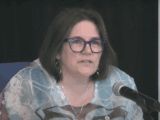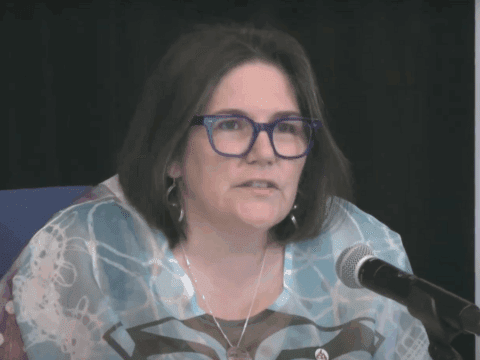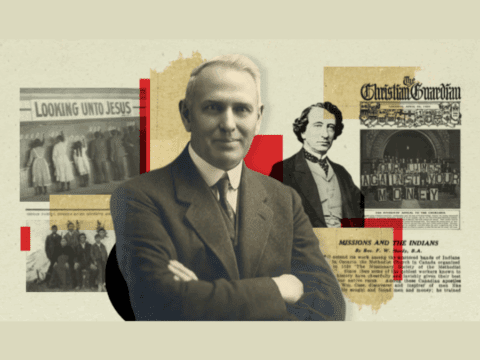Are you over age 60, born in Canada, female, married and well educated? According to a new survey of United Church worshippers, you are among the majority. You also believe strongly in the power of prayer and want a church “where God’s presence is felt.”
The findings are part of an identity survey commissioned by the General Council Office and conducted last summer. Billed as the largest in the history of the church, the $150,000 survey was designed to determine the demographics and core values or “identity and vision” of church people. Church leaders and staff will use the results to help set national policy and develop local ministries.
While many church people say the findings are no surprise, some of the results expose gaps between current General Council policy and what worshippers want in a church. And, despite a sunny narrative describing church people as being “in the full bloom of adulthood,” the survey reveals an aging denomination, with 82 percent of respondents over age 50.
Two accompanying surveys were also conducted at the same time: a poll of active United Church youth, which shows a strong cadre of leaders-in-waiting; and a survey of “affiliates” — those who name the United Church as their religious affiliation but rarely attend — which says few are seriously interested in connecting with a congregation.
Jane Armstrong Research Associates, the Toronto-based company that completed the survey, invited a representative but random sample of 607 pastoral charges to participate; 223 registered by the deadline. Then, about a third of those who attend worship in each pastoral charge completed surveys online or by mail.
With nearly 86 percent of the 7,448 respondents saying they attend church weekly, results point to a strong worshipping community. On average, respondents had been in their current congregation for 23 years; most were raised in the United Church, but one in 10 had no faith history before coming to the denomination. “What we have is . . . [a] ‘seeking’ people whose identity and vision is in full bloom, dedicated to their church and their faith,” researcher Jane Armstrong told the General Council Executive when she presented the results last November.
Other results are equally encouraging. Of survey respondents, 95 percent feel connected to their local church, and 64 percent said church plays a “very significant” role in their personal faith. Respondents see themselves more as members of the local rather than the national church, but most say the wider church — Presbyteries, Conferences and General Council — generally makes a positive contribution to local congregations.
Most believe that supporting their church financially is very important, and a majority have attended fundraisers or social events and done odd jobs at the church.
While 46 percent of respondents have helped with community outreach, almost 12 percent wrote to an elected official about a church-backed issue. That may not seem like much, says Armstrong’s report, but “when measured against the proportion of the population that exhibits that level of political engagement, it is impressive.”
Asked about United Church attributes that are most cherished, respondents “all put a high value on a church that is welcoming and supporting, where faith is translated into action, and where belief is not a matter of dogma but rather a journey of questioning, debate, doubt and ongoing discovery,” said the survey’s report.
This finding echoes research completed about six years ago in the lead-up to the Emerging Spirit campaign, a $10.5 million effort to interest 30- to 45-year-olds in joining the United Church. “The attributes that people hold dear do tend to be among the same ones” named by Emerging Spirit, says the report. Interestingly, the survey may also provide some evidence of Emerging Spirit’s success: worshippers in their 30s were most likely to have joined the church in the past five years.
When it comes to other faiths, most respondents see Christianity as “one path among many” — and 67 percent said they had talked about their faith to a non-churchgoer. This statistic came as a surprise to Nora Sanders, general secretary of General Council. “In today’s society, it’s not easy to talk about your faith with outsiders,” she said. “But most people do and have. . . . That was one that stood out as good news.”
The survey also reveals some bad news — particularly for those who hope to see the United Church survive for many generations to come. University of Lethbridge sociologist Reginald Bibby is an expert on Canadian religious and social research, and conducted the United Church’s last major survey, Unitrends, in 1994. Looking through the results of this study, Bibby says the age of active church people is its grimmest statistic.
“When you talk about a median age of 65, you have a very old church,” he says. Immigration no longer brings potential new members to Canada, and the church has been unable to attract people with children. “That’s one of the most startling messages. The obvious question is, what happens 20 years down the road?”
Rev. David Ewart of Vancouver, a retired minister with a knack for statistics, has a pretty good idea. About two years ago, he created trend charts that showed the United Church losing about a quarter of its congregations by 2025. The identity survey, he says, offers no reason to alter those predictions. Those who are active in the United Church now are “good people,” he says, but there’s a cultural shift away from all volunteer organizations, including churches. The United Church simply doesn’t have enough people under 50 to replace those who are over 50.
People who identify themselves as United Church on the government census have long been seen as good prospects. And census-based research, used to locate large concentrations of affiliates, has been widely used in some Presbyteries. But the poll of affiliates holds little hope of a large influx of new worshippers. Most of the 501 affiliates surveyed online have a positive perception of the United Church, but only three percent are “very likely” to start attending church. Most don’t feel they have to go to church to feel close to God and would rather spend their Sundays relaxing.
For those hoping new immigrants, people of non-European descent and other minority groups will help the United Church survive and thrive, there’s more bad news. Despite the General Council’s policy of becoming an intercultural and diverse church, sentiments in the pews reveal what Armstrong calls “a slight shadow of exclusionary attitudes.” Attributes related to promoting diversity — making worship accessible to people whose first language is not the primary language of worship; celebrating initiatives like Black History Month; using “expansive” language for God such as “Creator” or “Holy One”; and performing same-sex marriages — received low rankings from respondents.
The survey says 71 percent are very comfortable with a visible minority minister, but only 35 percent with a minister whose first language is not the congregation’s primary language. Half were very comfortable with a gay, lesbian or bisexual minister, and 27 percent with a transgender minister. (In contrast, the youth survey showed more openness to churches with diverse and intercultural attributes and more acceptance of different types of ministers.)
“People have not got the message [about the value of becoming intercultural] in spite of all the workshops and promotions and that sort of thing,” says Rev. Emmanuel Ofori, minister at Montreal’s Union United and an ethnic ministries representative to the General Council Executive. “I still see the idea of tokenism in the minds of some people. The message that the 39th General Council of 2006 sent to the church, that we wanted to become an intercultural church, didn’t sink in well.”
Getting back to Bibby’s question — What happens 20 years from now? — most respondents said they believe organized religion will survive, but a full 25 percent agree it’s time for organized Christianity “to fade away and something new to emerge.” Retired London Conference executive secretary Peter Scott of Chatham, Ont., says that’s “the prophetic thing that’s in the survey. . . . It’s just naming the truth. The fact that I go [to church] doesn’t mean that I don’t know the institution is finished.”
Whether the results are alarming or expected, the survey is getting mixed reviews for methodology and usefulness. Jane Armstrong is used to that. “People discuss the validity and the reliability of survey research all the time,” she says.
Bibby says the identity survey did a good job of ensuring regional representation and reaching committed churchgoers. “If they want the diehards, the people who are centrally involved . . . they’ve heard from them,” he says. He’s less sure about everyone else in the congregation. For the Unitrends survey, Bibby contacted a random selection of people on congregational membership rolls. Only about half were active members who worshipped weekly, so “we were getting a glimpse beyond the active core.”
Rev. Richard Hollingsworth, minister at Braeside Pastoral Charge in eastern Ontario, believes men, who are less likely than women to respond to surveys, are under-represented. Indeed, more than two-thirds of the respondents are women. Hollingsworth also notes the report doesn’t show a breakdown between urban and rural churches, and “assumes that all of our churches are the same regardless of their context, and they aren’t.” He argues that local ministries and national policy shouldn’t be based on the responses of such a small sampling — about four percent of worshippers.
Christine Williams, on the other hand, believes meaning can be found in the survey. As chair of the General Council committee that commissioned it and a lay minister at Ottawa’s Emmanuel United, she says the survey tells policy-makers “We’re going in the right direction, but let’s keep going. Keep making hard choices. Keep trying to figure out what are the core pieces of identity of the United Church.”
***
This story first appeared in The United Church Observer’s February 2012 issue with the title “Church by numbers.”















